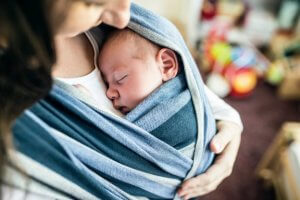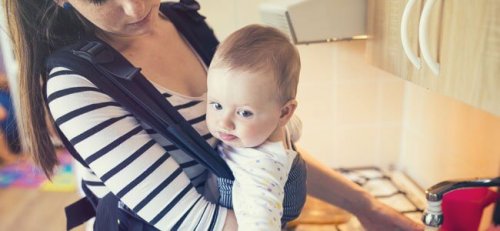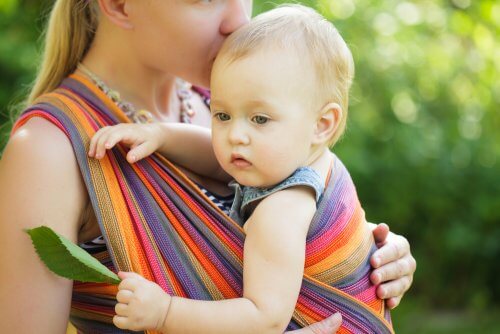Key Recommendations for Safe Babywearing


Written and verified by the nurse Miriam Barriga Sánchez
Currently, there is a wide variety of carriers that allow us to babywear: Backpacks, pouches, wraps, etc. It’s important to understand their function and know what points to keep in mind when choosing the right option when it comes to safe babywearing.
Babywearing offers a number of advantages when it comes to carrying and transporting our babies. Both parents as well as other caregivers can put it into practice and discover the benefits of this direct contact for everyone involved.
The benefits of safe babywearing
Some of the benefits that babywearing offers to babies are the following:
- Increased physical contact between baby and caregiver. This strengthens their bond and the baby’s sense of security.
- Decreased crying, and it also helps the baby to sleep better.
- Contributes positively to breastfeeding, encourages nursing on demand.
- Prevents positional plagiocephaly.
- Contributes to healthy attachment.
Some of the benefits of babywearing for parents and caregivers:
- Allows for greater mobility and autonomy, since strollers become unnecessary.
- Favors self-esteem.
- Reduces the risk of postpartum depression in mothers.
- Used correctly, babywearing devices protect and even strengthen back muscles.
When to begin babywearing
Backpack-type babywearing carriers shouldn’t be used with babies under the age of 6 months that cannot sit up on their own. If you want to babywear during the first 6 months of your little one’s life, you should choose a wrap-style carrier.
Wraps provide little ones with the support that their developing bodies need. These carriers respect newborns’ physiological posture, meaning their back is curved in the shape of a C.

Babywearing during this stage, if done correctly, is very beneficial to babies. It allows them to be in contact with their parents and caregivers, which provides a sense of calm and safety.
It’s vital that caregivers assure that the baby’s face remains uncovered and in sight at all times. That away, you can always make sure your little one is breathing correctly.
Should babies face inward or outward?
Babies should always be facing inward – that is, they should sit facing the person that is holding them. This is very important. If babies are situated facing outward, this negatively impacts their physiology, modifying the curvature of their spine.
Furthermore, the outward position causes their legs to dangle, increasing the risk of hip displacement. And finally, when babies are facing outward, they’re vulnerable to becoming overstimulated by the environment and are unable to find refuge.
For older babies, there are more options for safe babywearing. For example, they can be positioned on the wearer’s hip or back, which allows for greater visibility while still respecting the baby’s physiology. However, no matter where the baby is positioned, he or she should always face the wearer.
Ergonomic positioning
It’s very important that the carrier we use to babywear (backpack, wrap, pouch, etc), offer ergonomic positioning for both the wearer and the baby.
The wearer shouldn’t experience discomfort while babywearing. It’s important to try out different carriers before making a purchase to make sure you get something that adjusts correctly to your back. It’s also very important that the carrier doesn’t become loose-fitting while you’re wearing it.
Practice putting on the carrier without your baby first – this will make it easier to use. Ideally, you should choose something that adapts to your growing baby and that’s made of breathable fabrics. Avoid zippers and buttons, which may be bothersome.
During the first months of life, babies should be in a cradle position while in the wrap. Their faces should be visible at all times and at the right height to assure they can breathe easily. You should always follow expert advice when it comes to safe babywearing.
After 6 months of age, when babies can already sit up on their own, they can start using a backpack-style carrier. However, it’s very important that you choose a backpack that doesn’t leave your child’s legs hanging straight down.
This position doesn’t respect the anatomy of your little one’s hips and can lead to injury (hip displasia). Babies should be seated with their legs open to either side, knees bent. Their legs and bottom should form an “M”, and the base of the carrier should support your baby from one knee to the other.
How high should I position my baby?
You should always situate your baby at a height that allows him or her to move freely. Always make sure to leave space between the baby’s nose and your own body to allow unobstructed breathing and to keep his or her face visible. For example, you should be able to kiss your little one’s head easily once he or she is in the carrier.

Key recommendations for safe babywearing
- You should never babywear while in a moving vehicle. If you’re travelling, your little one should travel in a proper car seat, according to your baby’s weight and size.
- Babies should be able to move their heads while in carriers, and their faces should be uncovered so they can breathe.
- You should never babywear while performing tasks that put you at risk of falling (skating, climbing, biking, etc).
- Don’t cook while you’re babywearing, as this puts your baby at risk of being burned.
- Avoid slippery surfaces that could cause falls.
- Adjust the fit of your carrier to the size and weight of your baby and make sure your carrier is always in good condition.
In closing, be sure to consult with a professional if you have any doubts. We’re sure you and your baby will love the world of safe babywearing!
Currently, there is a wide variety of carriers that allow us to babywear: Backpacks, pouches, wraps, etc. It’s important to understand their function and know what points to keep in mind when choosing the right option when it comes to safe babywearing.
Babywearing offers a number of advantages when it comes to carrying and transporting our babies. Both parents as well as other caregivers can put it into practice and discover the benefits of this direct contact for everyone involved.
The benefits of safe babywearing
Some of the benefits that babywearing offers to babies are the following:
- Increased physical contact between baby and caregiver. This strengthens their bond and the baby’s sense of security.
- Decreased crying, and it also helps the baby to sleep better.
- Contributes positively to breastfeeding, encourages nursing on demand.
- Prevents positional plagiocephaly.
- Contributes to healthy attachment.
Some of the benefits of babywearing for parents and caregivers:
- Allows for greater mobility and autonomy, since strollers become unnecessary.
- Favors self-esteem.
- Reduces the risk of postpartum depression in mothers.
- Used correctly, babywearing devices protect and even strengthen back muscles.
When to begin babywearing
Backpack-type babywearing carriers shouldn’t be used with babies under the age of 6 months that cannot sit up on their own. If you want to babywear during the first 6 months of your little one’s life, you should choose a wrap-style carrier.
Wraps provide little ones with the support that their developing bodies need. These carriers respect newborns’ physiological posture, meaning their back is curved in the shape of a C.

Babywearing during this stage, if done correctly, is very beneficial to babies. It allows them to be in contact with their parents and caregivers, which provides a sense of calm and safety.
It’s vital that caregivers assure that the baby’s face remains uncovered and in sight at all times. That away, you can always make sure your little one is breathing correctly.
Should babies face inward or outward?
Babies should always be facing inward – that is, they should sit facing the person that is holding them. This is very important. If babies are situated facing outward, this negatively impacts their physiology, modifying the curvature of their spine.
Furthermore, the outward position causes their legs to dangle, increasing the risk of hip displacement. And finally, when babies are facing outward, they’re vulnerable to becoming overstimulated by the environment and are unable to find refuge.
For older babies, there are more options for safe babywearing. For example, they can be positioned on the wearer’s hip or back, which allows for greater visibility while still respecting the baby’s physiology. However, no matter where the baby is positioned, he or she should always face the wearer.
Ergonomic positioning
It’s very important that the carrier we use to babywear (backpack, wrap, pouch, etc), offer ergonomic positioning for both the wearer and the baby.
The wearer shouldn’t experience discomfort while babywearing. It’s important to try out different carriers before making a purchase to make sure you get something that adjusts correctly to your back. It’s also very important that the carrier doesn’t become loose-fitting while you’re wearing it.
Practice putting on the carrier without your baby first – this will make it easier to use. Ideally, you should choose something that adapts to your growing baby and that’s made of breathable fabrics. Avoid zippers and buttons, which may be bothersome.
During the first months of life, babies should be in a cradle position while in the wrap. Their faces should be visible at all times and at the right height to assure they can breathe easily. You should always follow expert advice when it comes to safe babywearing.
After 6 months of age, when babies can already sit up on their own, they can start using a backpack-style carrier. However, it’s very important that you choose a backpack that doesn’t leave your child’s legs hanging straight down.
This position doesn’t respect the anatomy of your little one’s hips and can lead to injury (hip displasia). Babies should be seated with their legs open to either side, knees bent. Their legs and bottom should form an “M”, and the base of the carrier should support your baby from one knee to the other.
How high should I position my baby?
You should always situate your baby at a height that allows him or her to move freely. Always make sure to leave space between the baby’s nose and your own body to allow unobstructed breathing and to keep his or her face visible. For example, you should be able to kiss your little one’s head easily once he or she is in the carrier.

Key recommendations for safe babywearing
- You should never babywear while in a moving vehicle. If you’re travelling, your little one should travel in a proper car seat, according to your baby’s weight and size.
- Babies should be able to move their heads while in carriers, and their faces should be uncovered so they can breathe.
- You should never babywear while performing tasks that put you at risk of falling (skating, climbing, biking, etc).
- Don’t cook while you’re babywearing, as this puts your baby at risk of being burned.
- Avoid slippery surfaces that could cause falls.
- Adjust the fit of your carrier to the size and weight of your baby and make sure your carrier is always in good condition.
In closing, be sure to consult with a professional if you have any doubts. We’re sure you and your baby will love the world of safe babywearing!
All cited sources were thoroughly reviewed by our team to ensure their quality, reliability, currency, and validity. The bibliography of this article was considered reliable and of academic or scientific accuracy.
- López Acuña, E.S., Salmerón Ruiz, M.A. (2014). El porteo ergonómico. Pediatr Integral XVIII (10): 774-780. Disponible en: https://www.pediatriaintegral.es/wp-content/uploads/2014/xviii10/09/n10-774-780_Int-Especial.pdf
- Sánchez Prados, F. (2014). Recomendaciones de uso de los cabestrillos portabebés. Comité de Seguridad y Prevención de Lesiones no Intencionadas en la Infancia (Asociación Española de Pediatría). Disponible en: https://www.aeped.es/comite-seguridad-y-prevencion-lesiones-no-intencionadas-en-infancia/documentos/recomendaciones-uso-l
- Sociedad Española de Pediatría Extrahospitalaria y Atención Primaria. (2015). El porteo ergonómico, una opción segura para transportar a los recién nacidos. SEPEAP. Disponible en: https://sepeap.org/el-porteo-ergonomico-una-opcion-segura-para-transportar-a-los-recien-nacidos/
This text is provided for informational purposes only and does not replace consultation with a professional. If in doubt, consult your specialist.








